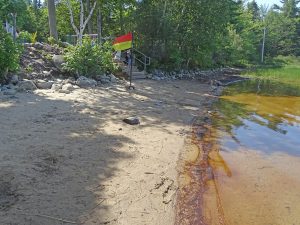
Swimmers left the beach at Sandy Lake Beach Park after an unpleasant algal bloom appeared suddenly in the morning of Aug 6, 2019. The bloom dissipated within a few days. It was as an ‘early warning sign’ that the lake is in a precarious state.
Since I began conducting observations on “Sandy Lake & Environs” in June 0f 2017, I have compiled a variety of observations related to Sandy Lake itself and associated streams and wetlands.
The observations included descriptions of wetland communities, some ‘limnological profiles” at deep spots in Sandy Lake, and many measurements of temperature, electrical conductivity ( a measure of the salt content) and pH of lake and stream waters. Derek Sarty, Bruce Sarty and Ed Glover have assisted with many of these observations.
I have been reporting the observations on various pages of this website, and it was getting difficult even for me to keep track if it all. So I decided I should put ‘the whole story’, including a review of previous studies, in one place.
That turned out to be a bigger job than I had anticipated as there were many loose ends to clean up and a lot of pertinent scientific literature I needed to review. Anyway, it all made it to a full Draft a few days ago: see A DRAFT Report On the State of Sandy Lake, the Historical Trends and its Future Trajectory
It’s not a light read, but there is a summary version.
There is good news and there is concerning news to come out of the exercise.
The concerning part: in a nutshell, Sandy Lake is in a precarious state, in large part associated with increased input of nutrients, organics and road salt associated with development (houses, roads industrial operations) within the watershed.
The good news, from the report:
Sandy Lake represents an enviable situation where we still have the option of choosing the most effective way to prevent the predictable and largely inevitable deterioration of a treasured lake associated with increasing urbanization: to strongly limit as yet unapproved development in the watershed, especially close to the lake itself and to streams draining into the lake.
View Summary
View Full Report
